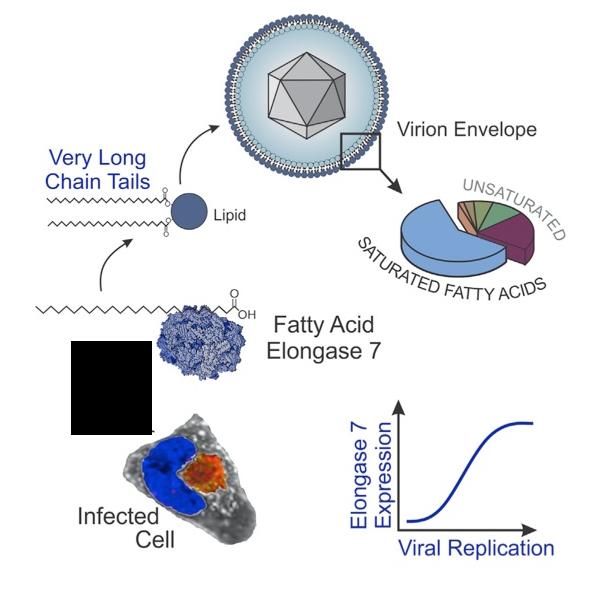More than 60 percent of the world's population is infected with a type of herpes virus called human cytomegalovirus, which replicates by commandeering the host cell's metabolism, but the details of this maneuver have been unclear.
Researchers have discovered that cytomegalovirus manipulates a process called fatty acid elongation, which makes the very-long-chain fatty acids necessary for virus replication. They identified a specific human enzyme - elongase enzyme 7 - that the virus induces to turn on fatty acid elongation.
"Elongase 7 was just screaming, 'I'm important, study me,'" said John Purdy, a post-doctoral researcher at Princeton and lead author of the study.

Credit: Rabinowitz lab
Purdy and colleagues found that once a cell was infected by cytomegalovirus, the level of elongase 7 RNA increased over 150-fold. Purdy then performed a genetic knockdown experiment to silence elongase 7 and established that in its absence the virus was unable to efficiently replicate.
"Elongases are a family of seven related proteins. The particular importance of elongase 7 for cytomegalovirus replication was a pleasant surprise, and enhances its appeal as a drug target," said Joshua Rabinowitz, a professor of chemistry at Princeton and co-author of the paper.
Activation of the elongase enzyme led to an increase in very-long-chain fatty acids, which are used by the virus to build its viral envelope and replicate. The researchers fed infected cells heavy isotope labeled C13-glucose, a molecule that is metabolized by the cell to form substrates for fatty acid elongation.
The heavy isotope carbon-13 atoms were incorporated into new products that were detected and identified by their mass using a specialized mass spectrometry method. This powerful technique provided insight into the amount of fatty acids produced and how they are constructed.
Cytomegalovirus infection mostly threatens populations with compromised immune systems and developing fetuses, and is the leading cause of hearing loss in children. Current treatments target the DNA replication step of the virus and are not very effective. These findings have advanced the understanding of the virus's operations and identified fatty acid elongation as a key process that warrants further study.
Citation: Purdy, J. G.; Shenk, T.; Rabinowitz, J. D. "Fatty Acid Elongase 7 Catalyzes the Lipidome Remodeling Essential for Human Cytomegalovirus Replication." Cell Reports, 2015, 10, 1375. This work was funded by National Institute of Health grants AI78063, CA82396, and GM71508 and an American Heart Association postdoctoral fellowship to J.G.P. (12POST9190001).




Comments